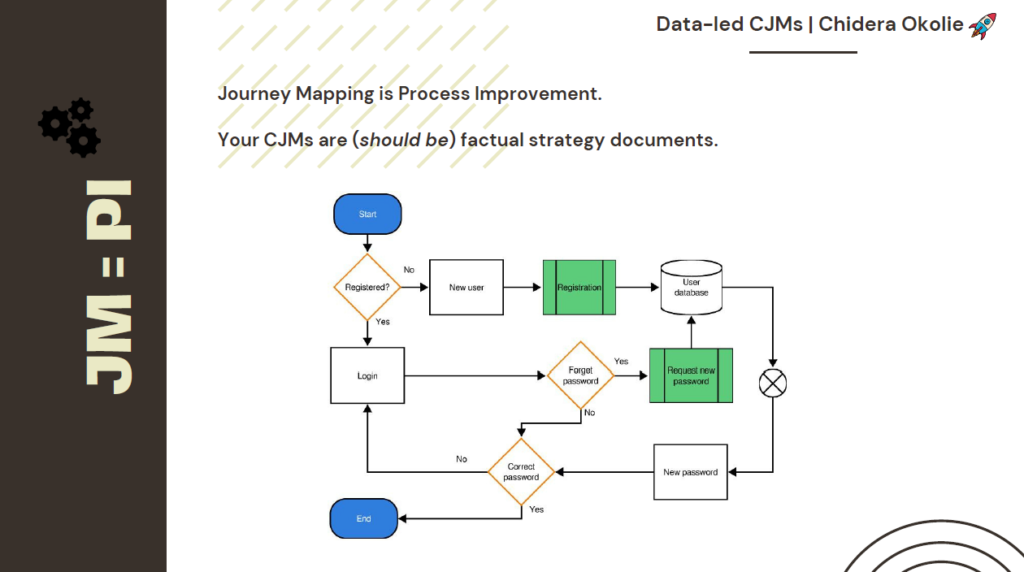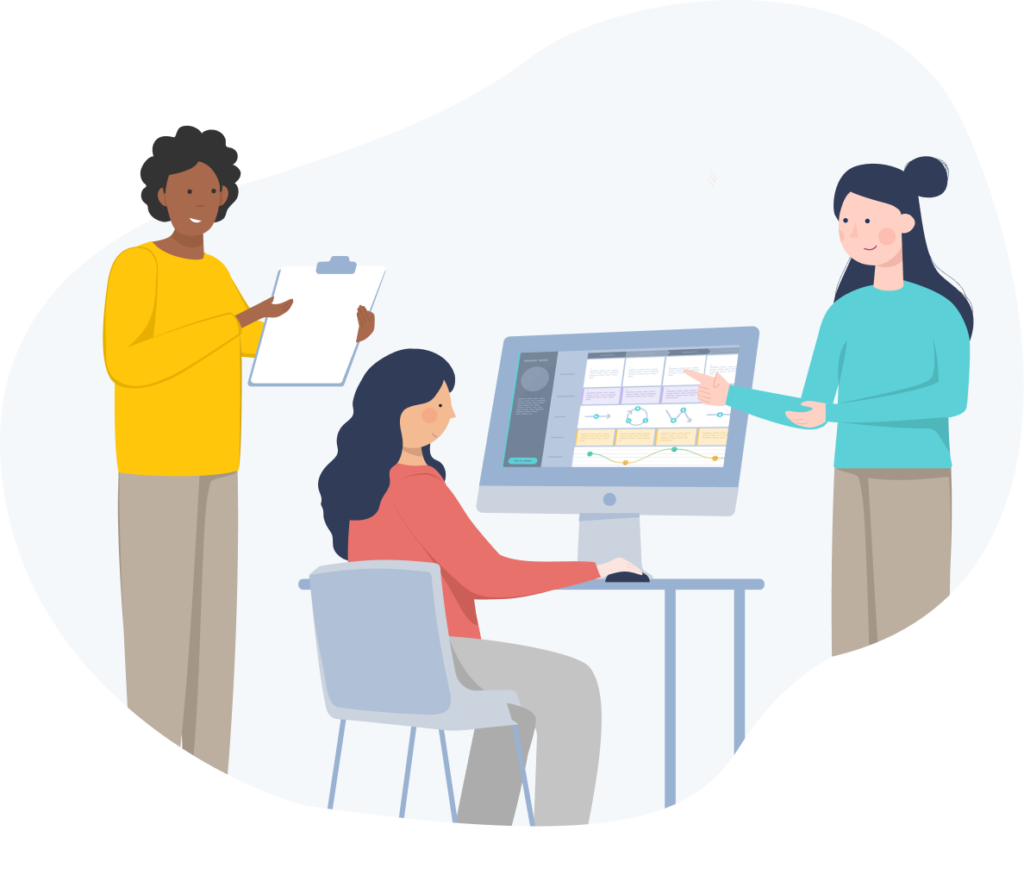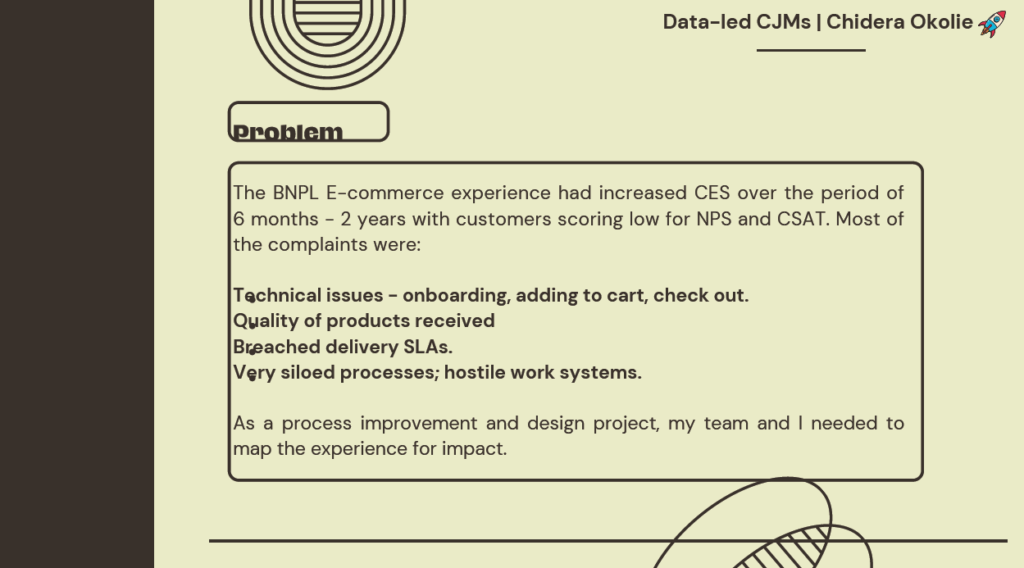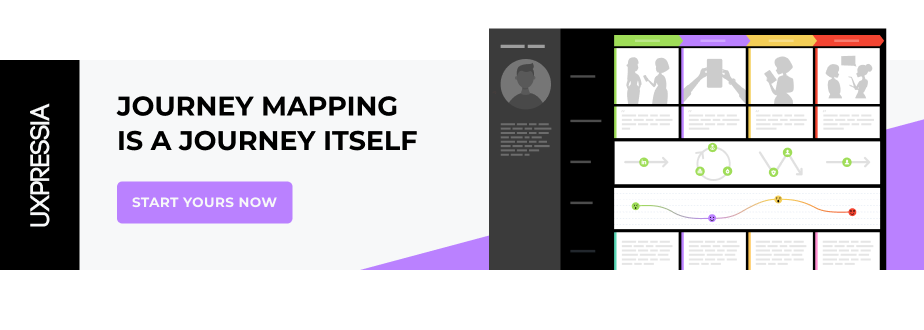Today, let's delve into the art of boosting organizational culture through journey mapping. We'll do this by drawing on the insights from Chidera Okolie, Customer Experience Designer at The Alternative Bank arm of Sterling Bank, and her recent online session hosted by UXPressia.
If you'd like to watch the entire session, there's a recording at the article's end. Enjoy!
Contents
Common challenges with journey mapping
Let's start with the most crucial aspect: What barriers do practitioners of journey mapping face? There are many, but Chidera highlights the following ones:
- It's hard to turn your maps into steps that actually change things.
- Different parts of a company often don't work together well, making it tough to map everything out fully.
- Getting everyone on board and understanding why journey maps are useful is tricky.
- Showing how maps can save or make money can be challenging.
- People often wonder if journey maps are worth it, especially compared to projects like marketing that get money more easily.
- Maps are especially valuable in the long run, not immediately, making it challenging to justify investing in them right away.
There are ways to overcome these challenges. And one of them is the approach that Chidera uses.
How we should approach journey maps

Our journey mapping approach significantly determines its success, echoing the classic perspective dilemma of seeing the glass as either half full or half empty. Here's how we navigate this:
- Perception matters: The way we view and describe the mapping process influences its trajectory and results. That’s why it is crucial to adopt a positive, strategic outlook.
- Collaboration is key: Journey mapping excels through teamwork, beginning with simple sketches and maturing into comprehensive plans. It's about the journey together, using alignment diagrams to foster team unity.
- Focus on clarity: Starting with a clear problem statement and a preference for visuals ensures we tackle the heart of the issue, keeping the solution in sight.
- Bring everyone in: Engaging a mix of teams and stakeholders enriches the process, blending insights from analytics and beyond to highlight areas for enhancement.
- Make it actionable: Documenting the current scenario helps spot challenges and opportunities, steering the initiation of targeted improvements.
In essence, mapping is more than a tool; it's a collaborative quest for clarity and action, guided by a shared vision and diverse insights.
Journey mapping as process improvement
At its core, journey mapping is a methodology for refining processes. It's about taking the time to understand and possibly redesign how things are done, aiming to improve, optimize, or innovate.
Viewing mapping through the lens of process enhancement shapes what and how we do things, from gathering data and engaging stakeholders to setting clear goals.

Customer journey maps are like game plans that show where a business has been, where it is now, and where it's going. They help us spot problems and set goals, making them key to guiding a business's strategy by tackling real, specific challenges.
Paying attention to metrics lets us really get what customers need, avoiding the trap of creating fancy maps that don't address real issues. It's all about focusing on the real hurdles a business encounters and ensuring our maps are rooted in solid evidence and facts.
The better the quality of a journey map, the more useful it is for improving business practices. A good map helps us stop doing what doesn't work and truly understand what customers go through without guessing. This way, we make sure to use our resources wisely.
Improving processes means actively looking for ways to perform better by cutting out waste and things that aren't efficient. It's about understanding the overall goals, aligning our actions with them, and talking clearly with everyone involved to get their backing.
To sum it up, mapping out customer journeys and processes is key to really making things better and affecting the success of a business. These tools are like a map that shows us how to go from where we are to where we want to be, and they're essential for dealing with complex business activities and reaching our goals. Using visuals makes things clearer and helps bring people together to work towards the same aims, showing just how crucial accurate and detailed mapping is for improving how a business runs.
Every stage matters
Teams sometimes overlook how working together across different areas can make customers happier. Customers don't see the separate teams in a business; they see one company.
For example, when someone buys something online, they don't think about all the different teams working behind the scenes. They only want their purchase to arrive smoothly. They thank the company, like Amazon, without thinking about the many steps that made their order possible. This example shows why it's important for all parts of a company to work well together to provide customers with a good experience.
When teams in a company don't work closely together, it can lead to problems because customers expect everything to work as one flawless service. Even a small delay or a missing check can cause issues down the line, affecting what the customer gets.
Improving how things are done can mean making a single process better, changing how things work across the company, or always looking for ways to improve. It's all about figuring out what steps add value, which don't, and which are needed but don't directly add value.
The goal is to eliminate steps that aren't helping make the product better or the customer happier. That makes the company work more efficiently and ensures everything done adds value or is necessary for a good reason.
Customers are happy to pay more if the extra work improves the product. But even though some steps don't directly add value, they might still be needed because of rules or other reasons. It's critical to understand which steps really add value, which are necessary but don't add value, and which could be cut out. This helps in planning how to improve processes, aiming to make every part of the process as good as it can be for both the customer and the company.
As-is, to-be, and realized mapping
In process mapping, it's crucial to depict reality, not ideals. This approach ensures we tackle real problems instead of imaginary ones and strive for the best outcomes. Collecting extensive data upfront, like demographic details, allows for a comprehensive understanding and flexibility in focusing on specific aspects later. This broad data collection is vital for effective analysis and process improvement.
After understanding the current process ("as-is"), we envision an ideal future ("to-be"), allowing for creative, rule-free thinking. This vision, informed by current insights and challenges, sets high goals.
Finally, we develop a practical plan ("realize" map) to bridge the current state to the desired future, translating ambitious visions into actionable steps. This sequential approach—from accurately mapping the present through visionary future planning to creating a realistic action plan—is key to successful process improvement.
Tips and tricks for accurate mapping

When it comes to improving processes, it's better to start with big dreams because it's easier to scale down ambitious ideas than to try to beef up small ones. It is especially handy when you're talking about potential risks and how much money you might need with your team.
For example, if you suggest a $100 million budget for your ideal process, it's easier to adjust it to $80 million later rather than trying to increase a modest $20 million proposal from the start. But it's important to keep these big dreams realistic, leading to a "realized" map that shows a doable plan, one that's well-informed by both your high hopes and the actual limits you face.
Good journey mapping steers clear of guesses. The more accurate your maps are, the better your chances of actually improving things rather than making them more complicated. So make sure your maps are based on real data and experiences, and try to gather as much information as you can to back up your work. Start with clear goals and really understand why you're doing what you're doing, making sure everything is based in reality for results that really mean something.
Dig into the issues by identifying what needs to be fixed or achieved. Talk to everyone involved, from experts to people actually using your service, and make sure the problems you're focusing on are genuine. Looking at different points of view can help spot where things aren't lining up right, like if the customer service team and the delivery team have very different ideas about what's happening.
Listen to everyone who has a part in the process, recognizing that different groups might see things differently, and that's okay. It's like in art class, where everyone's drawing the same object but from their own perspective. Remember, every little bit each team does adds up in the customer's journey. Even small actions play a part in the bigger story, like puzzle pieces coming together. When collecting information, talk to as many people as possible and value the insights from those who deal directly with your customers.
Get in touch with all the essential players and understand their role in the process. This could mean talking to different levels of staff in a call center, for example, to get a range of viewpoints. Tailor your approach to communication-based on who you're talking to and what you're trying to find out, always keeping the end user in mind.
Think about who your end users are based on the type of business or process you're looking at. Your strategy might change whether you're dealing with other businesses, consumers directly, or internal processes. Aim to gather as much info as possible, especially from outside your own organization, like listening to customer service calls for insights.
Using an empathy map can help you understand why customers make the choices they do, recognizing that buying is often more about feelings than logic. How customers feel about your product or service significantly impacts their decisions. Techniques like predictive selling, where suggestions are made based on past behavior, tap into these emotions to encourage more sales. Ignoring customers' feelings can lead to lost chances and unhappy customers because how they feel about their experience can make or break their buying decision.
Helpful personas: how to come up with such

Listening to what customers have to say is crucial, from complaints about waiting too long on the phone to wanting more personalized service. You can listen to actual customer calls or create fake scenarios to get a feel for what customers are going through. Using social media to keep an eye on what people say about your brand can also give you valuable insights into their views and what they like or don't like.
Being the go-between for the business and its customers means you need to understand both sides well. Getting deep into the process helps you see what customers need and what the business wants to achieve. This important role helps ensure customers get what they're looking for and the business meets its targets.
Your job is to find the right balance between what customers want and the business needs. By acting out the customer experience yourself, you can feel what it's like for customers and spot where the business might be going wrong or taking risks. Talk to customers directly and try out the service or product yourself. When making empathy maps, break down your customer base, collect and sift through data, and create detailed profiles to really get what different customers need.
Make sure these profiles are based on solid data, avoiding any unnecessary fluff and zeroing in on actual needs. Just as a watch meets the basic need to tell time, whatever you're offering should fulfill a real need for your customers.
Mapping the ROI
Understanding the ROI means looking at what opportunities and time are being lost. It's essential to get what the customer and the business want, even though these needs might not always match. A business might focus on getting more customers, but customers are looking for more than just being part of a transaction.
It's key to make customers feel special and not just like they're one in a crowd. While a business might be all about getting new customers, those customers are more interested in a smooth and quick start with the service or product. Knowing what both sides want is vital for doing well. Not seeing how their needs differ can lead to problems. For instance, a business might be trying to get more customers, but those customers just want good service.
If we only focus on how things work and forget how customers feel during their journey, we might miss out on ensuring they have a good experience. This could end up hurting how well things work overall. To do well, we need to think about what the customer and the business need at every step. This big-picture view helps us see how every part of the process affects the whole experience.
E-commerce case study
Chidera shared a use case from her own experience to better illustrate her point.

In the journey to refine the "Buy Now, Pay Later" (BNPL) e-commerce experience, Chidera encountered a significant challenge: an increase in the Customer Effort Score (CES), indicating that users found the service increasingly difficult to navigate. This discovery set her on a path to simplification, aiming to make every interaction as effortless as possible.
The first step in her approach was to look at how the service could reduce the number of steps customers needed to take, starting with integrating user-friendly features like signing up with Google. This saved users time and set a precedent for how the company could enhance the overall customer experience by minimizing effort.
Drawing upon Norman's design principles, Chidera recognized the importance of making our website usable and memorable. This step made her question the necessity of complex passwords and convoluted navigation paths, pushing the company towards a design that emphasized simplicity and ease of use.
Effective communication became a cornerstone of her strategy, especially when it came to error messages. Chidera realized that reducing customer effort was about more than streamlining processes. It was about clear, concise communication that provided users with straightforward solutions to their problems, thereby reducing frustration and anxiety.
As Chidera delved deeper into the project, she identified a range of issues affecting the BNPL experience, from technical glitches to onboarding and checkout complications. Each issue was a piece of the puzzle, highlighting the need for a comprehensive understanding of business objectives and customer expectations.
This holistic view informed the development of actionable strategies, where simplification and clear communication were key. By focusing on these areas, the company aimed to bridge the gap between current challenges and an ideal user experience that required minimal effort from the customer's perspective.
The importance of continuous feedback and data-driven decision-making became evident throughout this process. Each step, from identifying issues to implementing solutions, was guided by insights gathered from both the business and its customers. This approach ensured that Chidera’s efforts were logical, interconnected, and aligned with the ultimate goal of enhancing the BNPL e-commerce experience for users and the business.
Wrapping up
Concluding our dive, it's evident that journey mapping is more than mapping; it's a strategy to elevate customer experiences from concepts to impactful realities. Chidera Okolie's insights highlight the need for a data-driven approach, blending analysis with creativity to surpass expectations.
Journey mapping closes the gap between transactions and genuine connections, balancing operational efficiency with customer satisfaction. Despite challenges, a collaborative, clear, and actionable mindset is key to success.
Journey mapping isn't just a tool; it's a philosophy of continuous improvement and meaningful customer interactions. By focusing on the customer's voice, uniting teams, and using data smartly, we can craft customer journeys that not only meet but touch our audience deeply. Let's use these insights to foster growth and innovation, making every customer journey deeply memorable.
The recording
A full hour of enthralling speech straight from Chidera Okolie. Click play to dive in.
🎤 About the speaker
Chidera Okolie is the Customer Experience Designer at The Alternative Bank arm of Sterling Bank. She leads customer and product experience strategy, journey management, research, journey mapping, process optimization, and business improvement for B2B, B2C, BNPL, e-commerce, and B2B2C retail financial products and services.
She manages customer strategy and growth for the large bouquet of the bank’s retail financial products and services. She absolutely loves optimizing customer and product journeys to be more customer-centric, eliminate wasteful processes and simply be the best.
Her favorite other thing to do is learn German on Duolingo, listen to personal finance, experience design and strategy podcasts.







